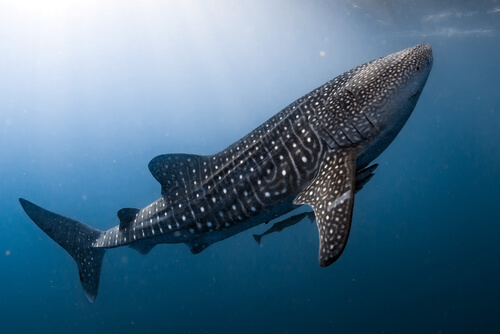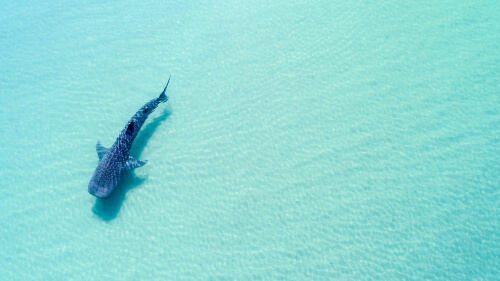
The Whale Shark is the largest species of extant shark. Unlike most sharks, they are planktivores: slow-moving filter feeders that feed exclusively on microscopic plankton. Whale sharks can reach large sizes of more than 60 feet long and can weigh as much as 42,000 pounds. Their mouths, located at the front of their heads, are lined with some 300 rows of very small teeth and 20 so-called filter pads, which they use to filter their food from the water. Their heads are wide and flat and they have two small eyes near the front corners. They also have large gills on either side of their heads. The skin on their top side is dark grey with white spots. Their underside is white and they have two dorsal fins set towards the rear of the animal and a pair of pectoral fins and a single anal fin. Despite their enormous size, whale sharks are not known to be aggressive or dangerous, and will often circle groups of snorkelers and divers calmly. They also do not prey on large animals nor possess the large, dangerous teeth that are so well-known to many predatory shark species such as the great white shark. Whale sharks are most commonly found in tropical waters around the world, rarely venturing into waters below 70 degrees. They are primarily pelagic, meaning they spend their time in deeper, open-ocean waters. They generally are found in the first few hundred meters of the water column, which is where their main food items are normally found. However, they have been known to dive to great depths of nearly 6,000 feet in search of food! Most of the time, whale sharks are solitary, but they will come together in feeding aggregations in some parts of the world including Belize, South Africa, and Western Australia. In one recorded event near the Yucatan peninsula of Mexico, more than 400 whale sharks were counted, one of the largest known gatherings of this type ever observed. Whale sharks spend much of their time following plankton blooms around the ocean, feeding on them by drawing large amounts of water into their mouths as they move slowly, often near the ocean’s surface. Specialized gills then filter out the tiny organisms from the water and into the whale shark’s digestive system. Due to the sheer size of adults, they have virtually no natural predators, although they are often hunted or killed by humans. Newborns and juveniles, however, do face the threat of predation by large predators such as other sharks and marlins that will gladly take advantage of the vulnerable young. The whale shark lifecycle is not currently well understood. Mating has rarely been observed, and the birth of pups has never been observed. In 1996 a pregnant female was captured and 300 pups were found inside her body. This confirmed that whale sharks are ovoviviparous, with their eggs developing inside their body and females giving birth to live, partially developed young. There exists some evidence to suggest that not all pups are born at once but rather than females steadily produce offspring over a period of time, often using retained sperm to sustain the cycle between breeding events. Due to a lack of understanding of the species’ life cycle and behavior, there is currently no reliable estimate of the global whale shark population. The IUCN Red List of Threatened Species considers the whale shark to be endangered as it is a common victim of by-catch in fisheries and is often the victim of vessel strikes. When combined with its long life-span and relatively late onset of sexual maturity, it is not difficult to see why there are concerns about the sustainability of the species. Whale sharks are one of the most beloved and famous species in the world and yet relatively little is known about them. Nonetheless, there are still many fun facts and biological concepts that can be explored. The name of whale sharks is in reference to their size. Although they are sharks, they are as large as many species of whales. In addition, they are filter feeders, much like many species of whales known as baleen whales. So despite being sharks, they have more in common with the mammals after which they were named than just size. Whale sharks are the world’s largest fish. The largest individual ever confirmed was 62 feet long! The blue whale, a mammal, is the largest animal that has ever lived. Although the whale shark is indeed a type of shark, it is not hard to imagine why it was named after its larger mammalian counterparts. Despite its size and title, whale sharks are not generally a threat to humans. In fact, they are quite docile and in many parts of the world tourists often safely swim alongside them as they feed on microscopic plankton, their only food item. Bands in the vertebrae of whale sharks and other species allow scientists to determine their age. Much like the growth rings of trees, these can be observed and counted in whale sharks and other hard parts of some animals. The space between the rings is compared with the rate of growth of whale sharks to determine their age. This method has demonstrated that whale sharks generally live from about 70-100 years of age, but may even reach as many as 130 years of age in some cases. However, some debate still exists on whether these visible bands are formed annually or biannually, leaving some uncertainty around the estimated age range of whale sharks. A 2020 study seems to have determined that, indeed, the rings are created annually and the whale sharks do live to impressive ages. Whale sharks have a unique appearance, with dark grey skin and white spots and lines on their topsides. Interestingly, these spots have been observed to be unique to each individual and can act as an identifying feature. Just like fingerprints are used to confidently identify humans, the spots on a whale shark can be used in the same way. Although not likely to be useful in solving crimes, this ability to identify individuals helps scientists to study the species as they move throughout the oceans and are observed in various locations. Whale sharks are fish and, thus, have scales. However, the scales of sharks are small and hard, giving them a smooth-like appearance. These small scales are known as dermal denticles, and the whale shark has a unique type found on its eye that is less common to other species. These scales, or denticles, are different from the ones along its body but still serve to protect the eye from damage. In addition, whale sharks have the ability to retract their eyes deep into their sockets to further protect them.
Kingdom
Animalia
Phylum
Chordata
Class
Chondrichthyes
Order
Orectolobiformes
Family
Rhincodontidae
Genus
Rhincodon
Species
R. typus
Niche
Pelagic Planktivore
Length
Up to 62 feet (19 m)
Weight
42,000 lbs (19,000 kg)
Lifespan
70-100 years
Social Structure
Solitary or in Small Shoals
Conservation Status
Endangered
Preferred Habitat
Coastal and Offshore waters
Average Number of Young
300
Main Prey Species
Zooplankton, Phytoplankton
Predators
Humans, Sharks, Marlin
The Basics
Description

Distribution and Range
Diet and Predators
Reproduction
Conservation Status
Fun Facts about the Whale Shark!
Whale or Shark?
A Big Fish

An Old Fish
Special Spots
Eye Safety
